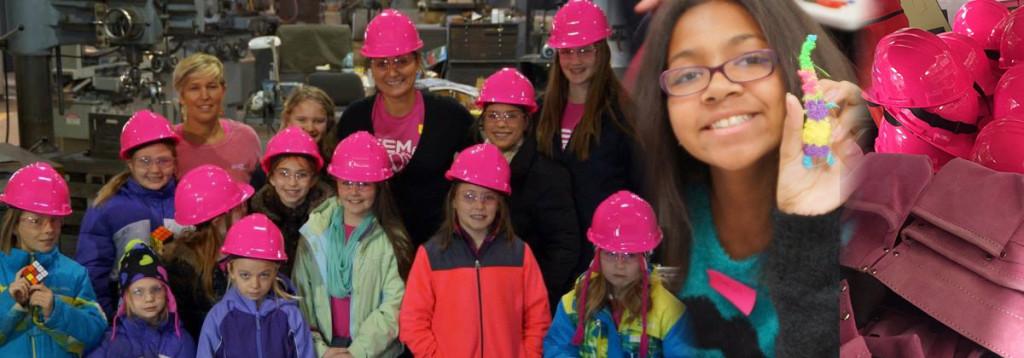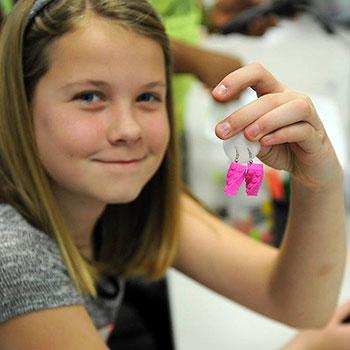 There’s been a lot of debate on how to get young girls more involved in the STEM (science, technology, engineering, and math) curriculum. There’s some controversy about the practice of “pinkifying” tech in order to allegedly make it more interesting to females; the implication is that to get girls and women interested in science and tech, we need to apply it to things they understand, e.g., clothes, jewelry, and other “girly” things. It’s a condescending attitude that infuriates many women who have made careers building rocket engines and developing cures for deadly diseases, but when it comes to kids, it’s not necessarily always harmful.
There’s been a lot of debate on how to get young girls more involved in the STEM (science, technology, engineering, and math) curriculum. There’s some controversy about the practice of “pinkifying” tech in order to allegedly make it more interesting to females; the implication is that to get girls and women interested in science and tech, we need to apply it to things they understand, e.g., clothes, jewelry, and other “girly” things. It’s a condescending attitude that infuriates many women who have made careers building rocket engines and developing cures for deadly diseases, but when it comes to kids, it’s not necessarily always harmful.
What makes STEM Divas different is that it doesn’t assume that all girls are interested only in pink and glitter, but recognizes that some girls, particularly very young ones, do respond better to new ideas when they’re dressed up in a pretty package. Pettee Guerrero, a STEM Outreach associate for Northern Illinois University, created the program to appeal to the “girly-girls” who have eschewed science as presented in their classrooms. Some girls, of course, eagerly jump right in to STEM coursework, but others consider it “uncool.”
STEM Divas makes that coursework “cool” by applying it to the interests of this particular segment of girls in the 7- to 10-year-old age range. The program meets once a month on Saturdays at the Northern Illinois University campus, and involves such activities as building jewelry boxes, tie-dyeing clothing, or making soap and lip gloss while learning about the tools and chemistry that go into the processes (and while wearing bright pink hard hats and goggles). The most recent class, which took place on February 6, introduced girls to 3D printing by teaching them how to design their own jewelry.
The four-hour class began with a lesson in how to design 3D models in Autodesk Fusion 360. Since there were only two 3D printers available, it wasn’t feasible for every girl to print her design, so each child was given a 3Doodler to create jewelry and other shapes.
“We showed them our 3-D printers, how they work and what the process is,” said Mackenzie Thompson, a sophomore mechanical engineering major and STEM Outreach student worker. “These pens are basically 3-D printers, but instead of using a computer, they’re using their brain.”
The next class will be on March 12, and will focus on the science of musical instruments. Each workshop is $42 and takes place from 9:00 AM to 1:00 PM. The program has already shown itself to be working; girls who previously showed no interest in science, or even actively disliked it, have changed their minds after realizing how it can be applied to their own interests.
“Our whole STEM Divas series, it’s just about getting girls interested in STEM and it’s about getting them more comfortable with it,” said Thompson. “A lot of studies have shown that one of the reasons girls don’t go into STEM is because it’s more focused toward boys, and so by having this class it’s kind of showing them that girls can do it and there’s a way to apply it in ways they’re interested in.”
In that respect, pinkifying can be a great starting point for young girls. Those same girls may grow up to be successful engineers or researchers who would laugh you out of the room if you suggested they try “hacking a hair dryer,” but at age 7, sometimes it takes a little glitter to spark their interest. Some STEM Divas participants have already announced that they have changed their career ambitions from ballerinas to engineers, so it looks as though Guerrero’s idea has hit the (pink) nail right on the head. What do you think of this angle for getting girls interested in STEM technology? Discuss in the STEM Divas 3D Print forum over at 3DPB.com.
Subscribe to Our Email Newsletter
Stay up-to-date on all the latest news from the 3D printing industry and receive information and offers from third party vendors.
You May Also Like
Why Corrosive Resistant Materials Are Important to the Success of 3D Printing Across Industries
The adoption of additive manufacturing (AM) is accelerating across many major industries. As this technological shift unfolds, the importance of corrosion resistance has emerged as a challenge for 3D printing...
America Makes Announces IMPACT 2.0: $6.6M in New 3D Printing Funding
America Makes, the Manufacturing Innovation Institute (MII) based in Youngstown, Ohio, has announced IMPACT (Improvement in Manufacturing Productivity via Additive Capabilities and Techno-Economic Analysis) 2.0, a project call which will...
3D Printing Webinar and Event Roundup: April 14, 2024
We’re starting off the week’s 3D printing webinars and events at ASTM AMCOE’s 11th Snapshot Workshop and MACH Exhibition. Stratasys continues its advanced training courses, SME is holding a virtual...
AMUK Welcomes Airframe Designs as British 3D Printing Industry Grows
While the UK is not the hub for 3D printer and materials manufacturers as other nations, the country continues to excel at the research, development, and application of additive manufacturing...


































